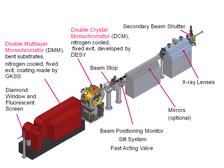Hutches and other components of the IBL (P05). The X-ray beam travels from left to right in this picture. EH1 is the first experimental hutch and EH2 is the second experimental hutch.
The Imaging Beamline is divided in three parts: the optics hutch, experimental hutch 1 (EH1) and experimental hutch 2 (EH2). The whole beamline is operated by the Helmholtz Zentrum Hereon. The experimental hutches use the same monochromated synchrotron beam and therefore can only be run at different times. The experiments are controlled from a common control hutch.
Beamline Optics
The main components inside the optics hutch are two liquid nitrogen cooled, fixed exit monochromators. A double crystal monochromator (DCM) equipped with a silicon single crystal [111] pair and a silicon [111] channel cut crystal. The DCM, designed by DESY, is either used for tomographic methods which need a very high monochromatization (ΔE/E ≈ 10−4, e.g. absorption edge tomography, vector tomography) or for setups requiring a highly stable beam in a lower energy range. For applications which need particularly high flux (e.g. fast in situ experiments) a double multilayer monochromator equipped with different mulitlayers (ΔE/E ≈ 10−2) is available.
Experimental Hutch 1 (Nano Tomography)
The nanotomography endstation in the experimental hutch 1 offers full field 3D imaging with resolutions down to 50 nm and scan times down to a few seconds, Magnification in the x-ray regime is realized by either a XTM or a cone-beam setup. Several imaging techniques are available, including Zernike phase contrast and holotomography.
Experimental Hutch 2 (Micro Tomography)
The micro tomography hutch is positioned at the second experimental hutch in a distance from source from 81 to 90 m. At this distance, the horizontal full width at half maximum of the beam is 5.6 mm which is sufficient to investigate millimeter sized samples with a spatial resolution down to the (sub)-micrometer range.








